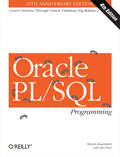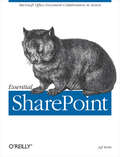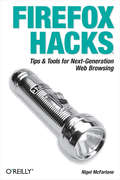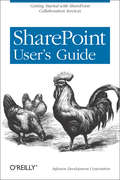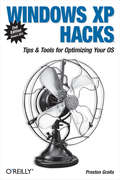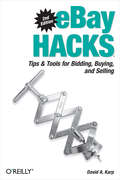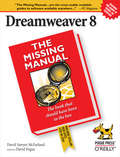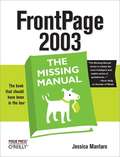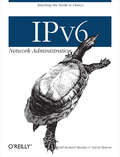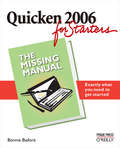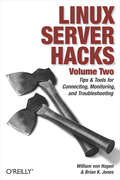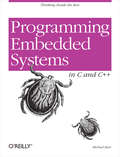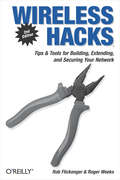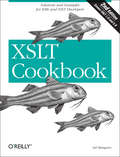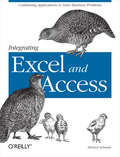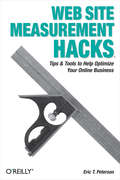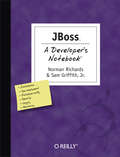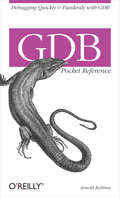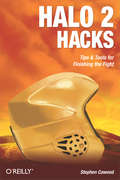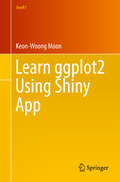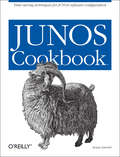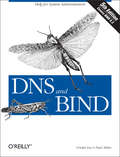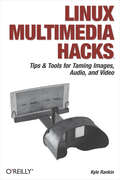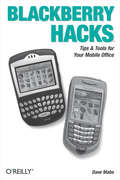- Table View
- List View
Oracle PL/SQL Programming
by Bill Pribyl Steven FeuersteinFor the past ten years, O'Reilly's Oracle PL/SQL Programming has been the bestselling book on PL/SQL, Oracle's powerful procedural language. Packed with examples and helpful recommendations, the book has helped everyone--from novices to experienced developers, and from Oracle Forms developers to database administrators--make the most of PL/SQL.The fourth edition is a comprehensive update, adding significant new content and extending coverage to include the very latest Oracle version, Oracle Database 10g Release 2. It describes such new features as the PL/SQL optimizing compiler, conditional compilation, compile-time warnings, regular expressions, set operators for nested tables, nonsequential collections in FORALL, the programmer-defined quoting mechanism, the ability to backtrace an exception to a line number, a variety of new built-in packages, and support for IEEE 754 compliant floating-point numbers.The new edition adds brand-new chapters on security (including encryption, row-level security, fine-grained auditing, and application contexts), file, email, and web I/O (including the built-in packages DBMS_OUTPUT, UTL_FILE, UTL_MAIL, UTL_SMTP, and UTL_HTTP) and globalization and localization.Co-authored by the world's foremost PL/SQL authority, Steven Feuerstein, this classic reference provides language syntax, best practices, and extensive code, ranging from simple examples to complete applications--making it a must-have on your road to PL/SQL mastery. A companion web site contains many more examples and additional technical content for enhanced learning.
Digital Photography Pocket Guide
by Derrick StoryEven film diehards have a tough time resisting the instant gratification of the digital camera. Today's digital cameras are more affordable then ever before, and they deliver high quality images that are a snap to share. Plus, you can take risks with a digital camera you never would with a film camera. You waste nothing; there's no film required, and because you only print the pictures you need, digital photography is cost effective and environmentally friendly. But to take full advantage of a digital camera, you need to be an experienced photographer and an expert at digital photography too. With more than 15 years of experience as a photojournalist, author Derrick Story brings you Digital Photography Pocket Guide, 3rd Edition. For everyone who owns or will own a digital camera (and that pretty much means everyone!), this is the perfect on-the-go guide for taking top-notch digital photos. In this third edition of the bestselling pocket guide, Story expands on the basic photography techniques that he introduced in earlier editions, including an explanation of each camera component and what it does, tips for choosing just the right settings for your needs, and much more. This indispensable guide covers everything from how to shoot sports action, close ups, and night shots, to dealing with image resolution, archiving, and memory cards. Affordable and portable, Digital Photography Pocket Guide, 3rd Edition offers full-color photographs, screen shots, and line art illustrating all the topics in the guide's three main sections ("Digital Camera Components," "Standard Camera Functions," and "How Do I?"). Contents are labeled A to Z for quick reference. There's also a comprehensive table of contents and index so you'll waste no time flipping to the specific information you need--whether you want to transfer images, make a QuickTime movie, or just figure out what purpose that mystery setting on your camera serves. There's even a section of easy-to-read reference tables for quick look-up of white balance settings, exposure compensation, camera mode explanations, and plenty more.
Essential SharePoint
by Jeff WebbWant to work more efficiently and effectively? Want to improve productivity? Microsoft is betting that you do. That's why it created Windows SharePoint Services--a set of collaboration tools that helps organizations increase individual and team productivity by enabling them to create web sites for information sharing and document collaboration. Through these team-oriented web sites, users capture and share ideas, and work together on documents, tasks, contacts, etc.--either among themselves or with partners and customers. And if you have Windows 2003 Server, then you already have SharePoint, since it's built right in. But before you can enjoy the benefits of SharePoint, you need to know how to turn it on, set it up, and get your applications working with it. Essential Sharepoint will help you do just that. It's not only the most complete guide for setting up and using these increasingly popular sites, but it also explains in detail the integration that makes SharePoint exciting. Everything you need to know about SharePoint is covered, including: hosting choices administration customization integration with Microsoft Office developing new SharePoint functionality when to use SharePoint portal serverEssential Sharepoint covers all the key topics for getting up and running with this powerful and popular set of collaboration tools. And it's not just for members of the IT staff. This comprehensive guide is for anyone in an organization who wants to explore Microsoft SharePoint in order to foster collaboration with other users.
Firefox Hacks
by Nigel McfarlaneFirefox Hacks is ideal for power users who want to take full advantage of Firefox from Mozilla, the next-generation web browser that is rapidly subverting Internet Explorer's once-dominant audience. It's also the first book that specifically dedicates itself to this technology. Firefox is winning such widespread approval for a number of reasons, including the fact that it lets users browse faster and more efficiently. Perhaps its most appealing strength, though, is its increased security something that is covered in great detail in Firefox Hacks. Clearly the web browser of the future, Firefox includes most of the features that browser users are familiar with, along with several new features, such as a bookmarks toolbar and tabbed pages that allow users to quickly switch among several web sites. Firefox Hacks offers all the valuable tips and tools you need to maximize the effectiveness of this hot web application. It's all covered, including how to customize its deployment, appearance, features, and functionality. You'll even learn how to install, use, and alter extensions and plug-ins. Aimed at clever people who may or may not be capable of basic programming tasks, this convenient resource describes 100 techniques for 100 strategies that effectively exploit Firefox. Or, put another way, readers of every stripe will find all the user-friendly tips, tools, and tricks they need to make a productive switch to Firefox. With Firefox Hacks, a superior and safer browsing experience is truly only pages away. The latest in O'Reilly's celebrated Hacks series, Firefox Hacks smartly complements other web-application titles such as Google Hacks and PayPal Hacks.
SharePoint User's Guide
by Infusion Development Corp.There's nothing like teamwork for making progress on a project, but sharing information and building on each other's successes can be challenging when your team is scattered across the miles. Microsoft's SharePoint helps teams and organizations close the distance. With SharePoint, groups construct web sites specifically for collaboration--sites where individuals can capture and share ideas, and work together on documents, tasks, contacts, and events. It's the next best thing to being in the room together. Unfortunately, much of the documentation for SharePoint is written to help system administrators get it up and running, which often leaves end users in the dark. The SharePoint User's Guide takes another approach: this quick and easy guide shows you what you need to know to start using SharePoint effectively and how to get the most from it. You'll learn how to create sites that your organization can use to work together or independently, from an end user's point of view. Now, even beginners can learn how to: access sites that are already set up create new sites personalize sites use the document and picture libraries for adding and editing content add discussion boards and surveys to a site enhance security You'll learn how you can receive alerts to tell you when existing documents and information have been changed, or when new information or documents have been added. You can even share select information with partners or customers outside your organization. No one that uses SharePoint collaboration services can afford to be without this handy book.The SharePoint User's Guide is designed to help you find answers quickly, explaining key concepts and major points in straightforward language. With SharePoint, any team or organization can overcome geographic or time-zone challenges, and the SharePoint User's Guide will show them how.
Windows XP Hacks
by Preston GrallaA smart collection of insider tips and tricks, Windows XP Hacks, Second Edition covers the XP operating system from start to finish. Among the multitude of topics addressed, this must-have resource includes extensive coverage of hot-button issues such as:securityweb browsingcontrolling the control panelremoving uninstallable XP componentspop-up adsYou'll also find timesaving hacks for file distribution; digital media, such as iTunes; and high-visibility web software, services, and exploits that have emerged since the book's last edition. Each hack in the book can be read easily in just a few minutes, saving countless hours of searching for the right answer.Now completely revised and updated to cover Service Pack 2 (SP2), the second edition of this bestseller carefully breaks down the new features that come with SP2, including IE pop-up blocker, Windows Firewall, and the new wireless client.Written by Preston Gralla, the compact and affordable Windows XP Hacks, Second Edition provides direct, hands-on solutions that can be applied to the challenges facing XP beginners, as well as the more experienced power user. Each year, Windows XP is pre-installed on 90 million PCs worldwide, making it the world's most popular operating system.
eBay Hacks
by David A. KarpWhatever you call it--an online auction house, the world's largest flea market, or a vast social experiment--no metaphor completely describes the huge trading community that is eBay. Underneath it all, eBay is also a computer program and a complex socio-economic system, requiring experience, finesse, and the right tools to master. eBay Hacks, 2nd Edition has been completely revised and updated to make use of an array of new tools and features, as well as to reflect the changes in the eBay API, eBay's policies, and general practices of its increasingly sophisticated users. In all, the new edition of eBay Hacks sports 30 brand-new hacks plus dozens of hacks that have been expanded, deepened, or otherwise completely rewritten. eBay Hacks shows you how to become a more efficient buyer and seller with clever tricks and shortcuts that will surprise even the most experienced eBayers. The book's wide range of topics covers all aspects of using eBay, such as advanced searching techniques, sniping tools, selling strategies, photography tips, and even research techniques for PowerSellers. But eBay Hacks doesn't just cover the basics; you'll learn how to write scripts to automate tedious tasks, take better photos, and tap into the eBay API to develop your own custom tools. Unlike any other book, eBay Hacks, 2nd Edition also provides insight into the social aspects of the eBay community, with diplomatic tools to help to get what you want with the least hassle and risk of negative feedback. This bestseller supplies you with the tools you need to master eBay, whether as a buyer or seller, casual surfer or serious collector, novice or seasoned expert. With this guide, you will become a savvy power user who trades smarter and safer, makes more money, enjoys successes, and has fun doing it.
Dreamweaver 8: The Missing Manual
by David Sawyer McfarlandAvailable for both the Mac and Windows, Macromedia's Dreamweaver 8 is a professional web design and development program used by millions of Internet professionals to build high-quality static and dynamic database-driven web sites. It offers drag-and-drop simplicity, streamlined HTML coding tools, and powerful database integration features. But Dreamweaver 8 is missing one vital component: a printed manual. Enter Dreamweaver 8: The Missing Manual, the completely revised fourth edition of this bestselling book by experienced web site trainer, Macromedia Certified instructor, and Dreamweaver Advisory Council member David McFarland. This book enables both first-time and experienced web designers to create visually stunning and highly interactive web sites. With crystal-clear writing and much welcome humor, this new edition offers features such as: Live examples: With McFarland's step-by-step annotated tutorials, you'll learn how to construct a state-of-the-art commercial web site, complete with working forms, Cascading Style Sheets (CSS), and dynamic databases. Tricks of the trade: The book is bursting with undocumented workarounds and shortcuts for easing the process of building, maintaining, and updating professional web sites. Design guidance: You'll learn to create virtually every modern web feature, including forms, animations, cascading menus, and more--and you'll find out which browsers you need to provide special coding or do extra testing with. No matter what your level of expertise is, you'll also learn how to manage your entire web site-whether you've just launched or if it's been around for awhile and takes up thousands of pages. Beginners with no web design experience will appreciate the step-by-step guide to designing, organizing, building, and deploying a web site; long-time Dreamweaver users will appreciate the advanced, real-world techniques for controlling the appearance of their web pages with CSS. With more than 500 illustrations, a handcrafted index, and the clarity of thought that has made bestsellers of every Missing Manual to date, this is the ultimate atlas for the complex and powerful Dreamweaver 8.
FrontPage 2003: The Missing Manual
by Jessica MantaroIn today's highly connected world, almost everybody has a web site, from local sewing circles to the world's largest corporations. If you're ready for one of your own, Microsoft's FrontPage 2003 has everything you need to create Web pages. It's true. Your geek friends may howl in contempt if you use FrontPage, but that's because the program has a reputation for spitting out cookie-cutter Web pages with messy, overloaded HTML code that takes forever to load. Not any more. After listening to complaints, Microsoft has given FrontPage 2003 some pretty advanced features, including an HTML cleanup tool that helps alleviate bloated code, and new support for Macromedia Flash and XML. Now, savvy Web veterans can control as much of the process as they want, and even collaborate on a site with developers who use Dreamweaver, GoLive or other Web authoring tools. Yet, unlike those other tools, FrontPage 2003 still has automated features for beginners who don't know where to start. There's still one flaw, though. Microsoft's idea of a user manual is a flimsy pamphlet. But that's easily solved. FrontPage 2003: The Missing Manual offers you everything from the basics to meaty sections on advanced tasks. Our book puts the program's features in context, with clear and thorough chapters that provide valuable shortcuts, workarounds, and just plain common sense, no matter where you weigh in on the technical scale. With it, you can learn to build simple Web pages, or sophisticated ones with tables and Cascading Style Sheets, and find out how to manage and publish a Web site. You'll also learn to create forms, work with databases, and integrate FrontPage with Microsoft Office. If you haven't worked with Web pages before, each chapter provides "Up to Speed" sidebars with useful background information. If you do have experience, the "Power Users' Clinic" sidebars offer advanced tips and insights. You won't find tips like those in the pamphlet, or even in the Help file. FrontPage: The Missing Manual gives you the complete lowdown on the program above and beyond any book on the market.
IPv6 Network Administration
by David Malone Niall Richard MurphyWhat once seemed nearly impossible has turned into reality. The number of available Internet addresses is now nearly exhausted, due mostly to the explosion of commercial websites and entries from an expanding number of countries. This growing shortage has effectively put the Internet community--and some of its most brilliant engineers--on alert for the last decade. Their solution was to create IPv6, a new Internet standard which will ultimately replace the current and antiquated IPv4. As the new backbone of the Internet, this new protocol would fix the most difficult problems that the Internet faces today--scalability and management. And even though IPv6's implementation has met with some resistance over the past few years, all signs are now pointing to its gradual worldwide adoption in the very near future. Sooner or later, all network administrators will need to understand IPv6, and now is a good time to get started. IPv6 Network Administration offers administrators the complete inside info on IPv6. This book reveals the many benefits as well as the potential downsides of this next-generation protocol. It also shows readers exactly how to set up and administer an IPv6 network. A must-have for network administrators everywhere, IPv6 Network Administration delivers an even-handed approach to what will be the most fundamental change to the Internet since its inception. Some of the other IPv6 assets that are covered include: routing integrated auto-configuration quality-of-services (QoS) enhanced mobility end-to-end securityIPv6 Network Administration explains what works, what doesn't, and most of all, what's practical when considering upgrading networks from the current protocol to IPv6.
Quicken 2006 for Starters: The Missing Manual
by Bonnie BiaforeIntuit's Quicken is one of today's most popular and convenient ways to keep track of personal finances, and Quicken 2006 For Starters: The Missing Manual for Windows is the indispensable guide to using the program to simplify your finances and make the most of your money. Whether you're new to electronic banking or just new to Quicken, this refreshingly funny and sensible book zeroes in on exactly what you need to get into Quicken fast. It teaches you how do such essential things as: balance your checkbook on your computer, keep tabs on your spending, create and manage a budget, monitor and pay bills on time, determine more ways to save and stick to your savings plan, manage loans and maximize investments, make tax preparation easier (even find hidden tax deductions!), and much more. Financial-software writer and personal finance expert Bonnie Biafore delivers clear explanations and step-by-step instructions for the Quicken features you need, as well as relevant advice and plenty of real-world examples. Beginners will appreciate Biafore's clear guidance on how to set up Quicken to streamline their money management tasks. Power users will benefit from her insightful tips, tricks, and shortcuts for working around Quicken's idiosyncrasies and saving even more time and money. The book is designed to help you get up to speed fast. Biafore steps you through the basics of Quicken. Then, as you become a more efficient and sophisticated Quicken user, she helps you take advantage of the program's little-known but powerful features. And throughout the book, she offers invaluable money-management principles. You'll be generating useful reports and graphs with ease; ensuring accuracy and consistency among all your accounts; and planning, saving, and controlling your finances like never before. The book that gives you exactly what you need, Quicken 2006 For Starters: The Missing Manual helps you quickly make the most of Quicken 2006 for Windows.
Linux Server Hacks, Volume Two
by William Von Hagen Brian K. JonesToday's system administrators deal with a vast number of situations, operating systems, software packages, and problems. Those who are in the know have kept their copy of Linux Server Hacks close at hand to ease their burden. And while this helps, it's not enough: any sys admin knows there are many more hacks, cool tips, and ways of solving problems than can fit in a single volume (one that mere mortals can lift, that is). Which is why we created Linux Server Hacks, Volume Two, a second collection of incredibly useful tips and tricks for finding and using dozens of open source tools you can apply to solve your sys admin problems. The power and flexibility of Linux and Open Source means that there is an astounding amount of great software out there waiting to be applied to your sys admin problems -- if only you knew about it and had enough information to get started. Hence, Linux Server Hacks, Volume Two. This handy reference offers 100 completely new server management tips and techniques designed to improve your productivity and sharpen your administrative skills. Each hack represents a clever way to accomplish a specific task, saving you countless hours of searching for the right answer. No more sifting through man pages, HOWTO websites, or source code comments -- the only resource you need is right here. And you don't have to be a system administrator with hundreds of boxen to get something useful from this book as many of the hacks apply equally well to a single system or a home network. Compiled by experts, these hacks not only give you the step-by-step instructions necessary to implement the software, but they also provide the context to truly enable you to learn the technology. Topics include: Authentication Remote GUI connectivity Storage management File sharing and synchronizing resources Security/lockdown instruction Log files and monitoring Troubleshooting System rescue, recovery, and repair Whether they help you recover lost data, collect information from distributed clients, or synchronize administrative environments, the solutions found in Linux Server Hacks, Volume Two will simplify your life as a system administrator.
Programming Embedded Systems
by Michael Barr Anthony MassaIf you have programming experience and a familiarity with C--the dominant language in embedded systems--Programming Embedded Systems, Second Edition is exactly what you need to get started with embedded software. This software is ubiquitous, hidden away inside our watches, DVD players, mobile phones, anti-lock brakes, and even a few toasters. The military uses embedded software to guide missiles, detect enemy aircraft, and pilot UAVs. Communication satellites, deep-space probes, and many medical instruments would have been nearly impossible to create without embedded software. The first edition of Programming Embedded Systems taught the subject to tens of thousands of people around the world and is now considered the bible of embedded programming. This second edition has been updated to cover all the latest hardware designs and development methodologies. The techniques and code examples presented here are directly applicable to real-world embedded software projects of all sorts. Examples use the free GNU software programming tools, the eCos and Linux operating systems, and a low-cost hardware platform specially developed for this book. If you obtain these tools along with Programming Embedded Systems, Second Edition, you'll have a full environment for exploring embedded systems in depth. But even if you work with different hardware and software, the principles covered in this book apply. Whether you are new to embedded systems or have done embedded work before, you'll benefit from the topics in this book, which include:How building and loading programs differ from desktop or server computers Basic debugging techniques--a critical skill when working with minimally endowed embedded systems Handling different types of memory Interrupts, and the monitoring and control of on-chip and external peripherals Determining whether you have real-time requirements, and whether your operating system and application can meet those requirements Task synchronization with real-time operating systems and embedded Linux Optimizing embedded software for size, speed, and power consumption Working examples for eCos and embedded Linux So whether you're writing your first embedded program, designing the latest generation of hand-held whatchamacalits, or managing the people who do, this book is for you. Programming Embedded Systems will help you develop the knowledge and skills you need to achieve proficiency with embedded software. Praise for the first edition: "This lively and readable book is the perfect introduction for those venturing into embedded systems software development for the first time. It provides in one place all the important topics necessary to orient programmers to the embedded development process. --Lindsey Vereen, Editor-in-Chief, Embedded Systems Programming
Wireless Hacks
by Roger Weeks Rob FlickengerThe popularity of wireless networking has grown exponentially over the past few years, despite a general downward trend in the telecommunications industry. More and more computers and users worldwide communicate via radio waves every day, cutting the tethers of the cabled network both at home and at work. Wireless technology changes not only the way we talk to our devices, but also what we ask them to do. With greater flexibility, broader range, and increased mobility, wireless networks let us live, work, and think differently. Wireless networks also open up a vast range of tasty new hack possibilities, from fine-tuning network frequencies to hot-rodding handhelds. The second edition of Wireless Hacks, co-authored by Rob Flickenger and Roger Weeks, brings readers more of the practical tips and tricks that made the first edition a runaway hit, selling nearly 30,000 copies. Completely revised and updated, this version includes over 30 brand new hacks, major overhauls of over 30 more, and timely adjustments and touchups to dozens of other hacks introduced in the first edition. From passive network scanning to aligning long-distance antennas, beefing up wireless network security, and beyond, Wireless Hacks answers real-life networking needs with direct solutions. Flickenger and Weeks both have extensive experience in systems and network administration, and share a passion for making wireless more broadly available. The authors include detailed coverage for important new changes in specifications and in hardware and software, and they delve deep into cellular and Bluetooth technologies. Whether you need your wireless network to extend to the edge of your desk, fit into your backpack, or cross county lines, the proven techniques in Wireless Hacks will show you how to get the coverage and functionality you're looking for.
XSLT Cookbook
by Sal ManganoForget those funky robot toys that were all the rage in the '80s, XSLT (Extensible Stylesheet Transformations) is the ultimate transformer. This powerful language is expert at transforming XML documents into PDF files, HTML documents, JPEG files--virtually anything your heart desires. As useful as XSLT is, though, most people have a difficult time learning its many peculiarities. And now Version 2.0, while elegant and powerful, has only added to the confusion. XSLT Cookbook, Second Edition wants to set the record straight. It helps you sharpen your programming skills and overall understanding of XSLT through a collection of detailed recipes. Each recipe breaks down a specific problem into manageable chunks, giving you an easy-to-grasp roadmap for integrating XSLT with your data and applications. No other XSLT book around employs this practical problem-solution-discussion format. In addition to offering code recipes for solving everyday problems with XSLT 1.0, this new edition shows you how to leverage the improvements found in XSLT 2.0, such as how to simplify the string manipulation and date/time conversion processes. The book also covers XPath 2.0, a critical companion standard, as well as topics ranging from basic transformations to complex sorting and linking. It even explores extension functions on a variety of different XSLT processors and shows ways to combine multiple documents using XSLT. Code examples add a real-world dimension to each technique. Whether you're just starting out in XSLT or looking for advanced techniques, you'll find the level of information you need in XSLT Cookbook, Second Edition.
Integrating Excel and Access
by Michael SchmalzIn a corporate setting, the Microsoft Office Suite is an invaluable set of applications. One of Offices' biggest advantages is that its applications can work together to share information, produce reports, and so on. The problem is, there isn't much documentation on their cross-usage. Until now. Introducing Integrating Excel and Access, the unique reference that shows you how to combine the strengths of Microsoft Excel with those of Microsoft Access. In particular, the book explains how the powerful analysis tools of Excel can work in concert with the structured storage and more powerful querying of Access. The results that these two applications can produce together are virtually impossible to achieve with one program separately. But the book isn't just limited to Excel and Access. There's also a chapter on SQL Server, as well as one dedicated to integrating with other Microsoft Office applications. In no time, you'll discover how to: Utilize the built in features of Access and Excel to access data Use VBA within Access or Excel to access data Build connection strings using ADO and DAO Automate Excel reports including formatting, functions, and page setup Write complex functions and queries with VBA Write simple and advanced queries with the Access GUI Produce pivot tables and charts with your data With Integrating Excel and Access, you can crunch and visualize data like never before. It's the ideal guide for anyone who uses Microsoft Office to handle data.
Web Site Measurement Hacks
by Eric T. PetersonIn order to establish and then maintain a successful presence on the Web, designing a creative site is only half the battle. What good is an intricate Web infrastructure if you're unable to measure its effectiveness? That's why every business is desperate for feedback on their site's visitors: Who are they? Why do they visit? What information or service is most valuable to them? Unfortunately, most common Web analytics software applications are long on functionality and short on documentation. Without clear guidance on how these applications should be integrated into the greater Web strategy, these often expensive investments go underused and underappreciated. Enter Web Site Measurement Hacks, a guidebook that helps you understand your Web site visitors and how they contribute to your business's success. It helps organizations and individual operators alike make the most of their Web investment by providing tools, techniques, and strategies for measuring--and then improving--their site's usability, performance, and design. Among the many topics covered, you'll learn: definitions of commonly used terms, such as "key performance indicators" (KPIs) how to drive potential customers to action how to gather crucial marketing and customer data which features are useful and which are superfluous advanced techniques that senior Web site analysts use on a daily basis By examining how real-world companies use analytics to their success, Web Site Measurement Hacks demonstrates how you, too, can accurately measure your Web site's overall effectiveness. Just as importantly, it bridges the gulf between the technical teams charged with maintaining your Web's infrastructure and the business teams charged with making management decisions. It's the technology companion that every site administrator needs.
JBoss: A Developer's Notebook
by Norman Richards Sam GriffithThere's nothing ordinary about JBoss. What began as an open source EJB container project six years ago has become a fully certified J2EE 1.4 application server with the largest market share, competitive with proprietary Java application servers in features and quality. And with its dynamic architecture, JBoss isn't just a J2EE server. You can alter the services to make J2EE work the way you want, or even throw J2EE away completely. After more than a million downloads, many JBoss users are no longer trying it out on internal test boxes, but rolling it out on production machines. JBoss: A Developer's Notebook takes you on a complete tour of JBoss in a very unique way: rather than long discussions, you will find code--lots of code. In fact, the book is a collection of hands-on labs that take you through the critical JBoss features step-by-step. You don't just read about JBoss, you learn it through direct practical application. That includes exploring the server's many configurations: from bare features for simple applications, to the lightweight J2EE configuration, to everything JBoss has in store-including Hibernate and Tomcat. JBoss: A Developer's Notebook also introduces the management console, the web services messaging features, enhanced monitoring capabilities, and shows you how to improve performance. At the end of each lab, you'll find a section called "What about..." that anticipates and answers likely follow-up questions, along with a section that points you to articles and other resources if you need more information. JBoss is truly an extraordinary application server. And we have an extraordinary way for you to learn it.
GDB Pocket Reference
by Arnold RobbinsMany Linux and Unix developers are familiar with the GNU debugger (GBD), the invaluable open source tool for testing, fixing, and retesting software. And since GDB can be ported to Windows, Microsoft developers and others who use this platform can also take advantage of this amazing free software that allows you to see exactly what's going on inside of a program as it's executing. This new pocket guide gives you a convenient quick reference for using the debugger with several different programming languages, including C, C++, Java, Fortran and Assembly. The GNU debugger is the most useful tool during the testing phase of the software development cycle because it helps you catch bugs in the act. You can see what a program was doing at the moment it crashed, and then readily pinpoint and correct problem code. With the GDB Pocket Reference on hand, the process is quick and painless. The book covers the essentials of using GBD is a testing environment, including how to specify a target for debugging and how to make a program stop on specified conditions. This handy guide also provides details on using the debugger to examine the stack, source files and data to find the cause of program failure-and then explains ways to use GBD to make quick changes to the program for further testing and debugging. The ability to spot a bug in real time with GDB can save you hours of frustration, and having a quick way to refer to GBD's essential functions is key to making the process work. Once you get your hands on the GDB Pocket Reference, you'll never let go!
Halo 2 Hacks
by Stephen CawoodEven if you've finished Halo 2 in Legendary Mode, you're not done with this game. Not by a long shot. You know there's a lot more you can squeeze out of Halo 2, and with the clever hacks we have in store, you'll turn the game into a whole new experience. Halo 2 Hacks is the creation of consummate gamer and Microsoft insider Stephen Cawood, an original member of the Halo 2 beta test team. He's got it all, whether you're into single or multiplayer games, a level 25 or above, or even a complete n00b. If you are a beginner, you may not yet appreciate that Halo 2 for Xbox is the biggest game to hit the galaxy. Ten million copies have already sold, including 2.4 million on the first day it hit the shelf. So you're in good company, even if you've never played its predecessor, Halo: Combat Evolved. Pick up this book and you'll be able to fully appreciate the Halo 2 universe. Halo 2 Hacks is packed with a horde of great hacks for weapons, levels, vehicles, game play and mods. You'll learn how to perform expert tricks, exploit glitches and find Halo 2 Easter Eggs - including the famous skulls. And discover all the nooks and crannies you didn't even suspect were there. Each hack has a thermometer icon to indicate its relative complexity, whether it's a beginner, moderate, or expert hack. Each one stands on its own, so you can either read the book from cover to cover, or jump around until you see a hack you want to try. This title was created with the help of numerous gamers from the Halo community. Whether it was a trick, a glitch or a mod, Cawood went straight to the source and gathered all of the necessary information to help you complete the hack. The mod section of the book features contributions from Grenadiac, MrMurder, Iron_Forge, GTJuggler, The Swamp Fox, and many more. Halo 2 Hacks also features a foreword by Ducain (the admin for HighImpactHalo.org), Louis Wu (the admin for Halo.Bungie.org) and Grenadiac (the admin for HaloMods.com). For all the brave souls who want to learn how to trick Halo 2 into running the hacks and mods of their choice, Halo 2 Hacks is a must read. Roughly half of this title is dedicated to creating your own Halo 2 mods. If you're a fan of tricking, glitching or modding, then this is the book for you. But only for gamers who think they're worthy of the distinction.
Learn ggplot2 Using Shiny App
by Keon-Woong MoonThis book and app is for practitioners, professionals, researchers, and students who want to learn how to make a plot within the R environment using ggplot2, step-by-step without coding. In widespread use in the statistical communities, R is a free software language and environment for statistical programming and graphics. Many users find R to have a steep learning curve but to be extremely useful once overcome. ggplot2 is an extremely popular package tailored for producing graphics within R but which requires coding and has a steep learning curve itself, and Shiny is an open source R package that provides a web framework for building web applications using R without requiring HTML, CSS, or JavaScript. This manual--"integrating" R, ggplot2, and Shiny--introduces a new Shiny app, Learn ggplot2, that allows users to make plots easily without coding. With the Learn ggplot2 Shiny app, users can make plots using ggplot2 without having to code each step, reducing typos and error messages and allowing users to become familiar with ggplot2 code. The app makes it easy to apply themes, make multiplots (combining several plots into one plot), and download plots as PNG, PDF, or PowerPoint files with editable vector graphics. Users can also make plots on any computer or smart phone. Learn ggplot2 Using Shiny App allows users to Make publication-ready plots in minutes without coding Download plots with desired width, height, and resolution Plot and download plots in png, pdf, and PowerPoint formats, with or without R code and with editable vector graphics
JUNOS Cookbook
by Aviva GarrettThe Juniper Networks routing platforms are becoming the go-to solution for core, edge, metro and remote office networks, and JUNOS software is behind it all. The operating system is so full of industrial-strength routing protocols and IP innovations that those treading into the world of JUNOS will need clarification, explanation, and a showcase example or two. Look no further. This JUNOS Cookbook provides it all and more. Yes, you can mine through the 5,000 pages of documentation or take a two-thousand-dollar training course, but JUNOS's interprocess sophistication can be baffling unless you know the shortcuts and tricks, as well as those rays of illuminating comprehension that can come only from those who live with it. JUNOS Cookbook is the first comprehensive book about JUNOS software and it provides over 200 time-saving step-by-step techniques including discussions about the processes and alternative ways to perform the same task. It's been tested and tech-reviewed by field engineers who know how to take JUNOS out for a spin and it's applicable to the entire line of M-, T-, and J-series routers. JUNOS Cookbook will not only pay for itself the first few times you use it, it will make your network easier to manage and update. "Aviva Garrett has done a tremendous job of distilling the features of JUNOS software in a form that will be useful for a wide audience-students, field engineers, network architects, and other networking professionals alike will benefit from this book. For many people, this is the only book on JUNOS they will need." Pradeep Sindhu, CTO and Founder, Juniper Networks "This cookbook is superb. Aviva Garrett has masterfully assembled a complete set of practical real-world examples with step-by-step instructions. Security, management, routing: it's all here!" Stephen Gill, Research Fellow, Team Cymru "A technical time-saver for any NOC or SOC working with JUNOS. It's clear, concise, and informative recipes are are an invaluable resource. " Scott A. McIntyre, Security Officer, XS4ALL Internet B.V
DNS and BIND
by Paul Albitz Cricket LiuDNS and BIND tells you everything you need to work with one of the Internet's fundamental building blocks: the distributed host information database that's responsible for translating names into addresses, routing mail to its proper destination, and even listing phone numbers with the new ENUM standard. This book brings you up-to-date with the latest changes in this crucial service. The fifth edition covers BIND 9.3.2, the most recent release of the BIND 9 series, as well as BIND 8.4.7. BIND 9.3.2 contains further improvements in security and IPv6 support, and important new features such as internationalized domain names, ENUM (electronic numbering), and SPF (the Sender Policy Framework). Whether you're an administrator involved with DNS on a daily basis or a user who wants to be more informed about the Internet and how it works, you'll find that this book is essential reading. Topics include: What DNS does, how it works, and when you need to use it How to find your own place in the Internet's namespace Setting up name servers Using MX records to route mail Configuring hosts to use DNS name servers Subdividing domains (parenting) Securing your name server: restricting who can query your server, preventing unauthorized zone transfers, avoiding bogus servers, etc. The DNS Security Extensions (DNSSEC) and Transaction Signatures (TSIG) Mapping one name to several servers for load sharing Dynamic updates, asynchronous notification of change to a zone, and incremental zone transfers Troubleshooting: using nslookup and dig, reading debugging output, common problems DNS programming using the resolver library and Perl's Net::DNS module
Linux Multimedia Hacks
by Kyle RankinThe fact that Linux has more multimedia application choices than Mac OS X and Windows combined may come as a surprise to many, but not to those who know Linux well. In Linux Multimedia Hacks, author Kyle Rankin showcases the best available multimedia tools so you can maximize the entertainment capabilities of your favorite OS. Included are tips and tricks for connecting to iPods, creating MP3s and Oggs, watching and making DVDs, turning your Linux box into a Tivo ala MythTV, and much more. You don't have to be a Linux server guru to make use of this book. Linux Multimedia Hacks takes the best of Linux's multimedia tools and with step-by-step instructions shows even novice users how to do cool and useful things with images, audio, and video. It includes entry level hacks that nearly all Linux users will want, such as installing codecs for audio and video playback and managing thousands of photographs. Later, you'll find hacks that cover a variety of advanced projects, from ripping and organizing media files with metatags, to editing video and audio tracks, to creating your own DVDs. Basic or advanced, each hack stands on its own, so you can feel free to jump around to only the sections that interest you. The book is divided into five easy-to-understand chapters: Images: tips range from basic image edits to automated image manipulation Audio: hacks include audio format conversion and tweaking metadata within audio files Video: learn how to covert between video formats, plus how to create your own VCDs and DVDs Broadcast Media: tips include how to access and create you own web broadcasts as well as watch and record TV Web: learn how to make your multimedia creations available to the world As one of the most powerful multimedia platforms around, Linux has far more capabilities and features than meets the eye. This latest Hacks book gives you the technical chops to enjoy them all.
BlackBerry Hacks
by Dave MabeThe BlackBerry has become an invaluable tool for those of us who need to stay connected and in the loop. But most people take advantage of only a few features that this marvelous communications device offers. What if you could do much more with your BlackBerry than just web surfing and email? BlackBerry Hacks will enhance your mobile computing with great tips and tricks. You'll learn that the BlackBerry is capable of things you never thought possible, and you'll learn how to make it an even better email and web workhorse: Get the most out of the built-in applications Take control of email with filters, searches, and more Rev up your mobile gaming--whether you're an arcade addict or poker pro Browse the web, chat over IM, and keep up with news and weblogs Work with office documents, spell check your messages, and send faxes Become more secure, lock down your BlackBerry and stash secure information somewhere safe Manage and monitor the BlackBerry Enterprise Server (BES) and Mobile Data System (MDS) Create web sites that look great on a BlackBerry Develop and deploy BlackBerry applications Whether you need to schedule a meeting from a trade show floor, confirm your child's next play date at the park, or just find the show times and secure movie tickets while at dinner, this book helps you use the remarkable BlackBerry to stay in touch and in-the-know--no matter where you are or where you go.
